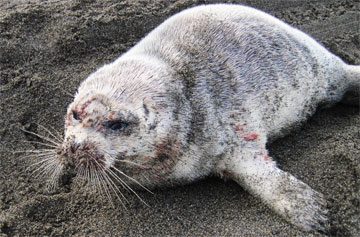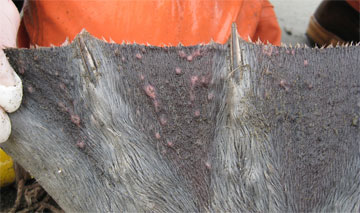
DEATHS OF RINGED SEALS IN ALASKA DECLARED AN UNUSUAL MORTALITY EVENT; WALRUS PENDING
December 27, 2011
Since mid-July, more than 60 dead and 75 diseased seals, most of them ringed seals, have been reported in Alaska, with reports continuing to come in. During their fall survey, scientists with the U.S. Fish and Wildlife Service also identified diseased and dead walruses at the annual mass haul-out at Point Lay. Seals and walruses suffering from this disease have skin sores, usually on the hind flippers or face, and patchy hair loss. Some of the diseased mammals have exhibited labored breathing and appear lethargic. Scientists have not yet identified a single cause for this disease, though tests indicate a virus is not the cause. Hunters continue to see numerous healthy animals, and despite considerable contact with seals by hunters and field research personnel throughout this event, no similar illnesses in humans have been reported. Still, it is not known whether the disease can be transmitted to humans, pets, or other animals. Native subsistence hunters should use traditional and customary safe handling practices, and the Alaska Division of Public Health recommends fully cooking all meat and thoroughly washing hands and equipment with a water/bleach solution. Any member of the public who encounters a seal or walrus that looks sick or behaves unusually, such as by not fleeing from humans, should avoid approaching or making contact with the animal. Sick or dead marine mammals should be reported to the following agencies, based on where the animal is seen:
Necropsies and laboratory tests to date have found skin lesions in most cases, as well as fluid in the lungs, white spots on the liver, and abnormal growths in the brain. Some seals and walruses have undersized lymph nodes, which may indicate compromised immune systems. Testing continues for a wide range of possible factors that may be responsible for the animals’ condition, including immune system-related diseases, fungi, man-made and bio-toxins, radiation exposure, contaminants, and stressors related to sea ice change. Walruses and ringed seals in Russia, and ringed seals in Canada, have reportedly suffered similar symptoms. While it is not clear if the disease events are related, the timing and location of the disease suggests the possibility of transmission between the populations, or shared exposure to an environmental cause. Since early November, federal agencies and partners have been consulting with the Working Group on Marine Mammal Unusual Mortality Events – a group of experts from scientific and academic institutions, conservation organizations, and state and federal agencies – to consider if the seal and walrus deaths met the criteria for an unusual mortality event. Late last week, the Working Group recommended NOAA and the Fish and Wildlife Service declare an unusual mortality event. The rigorous, collaborative investigation into these deaths has and will continue to involve the North Slope Borough, numerous organizations, local communities, Tribal entities, and members of the Alaska Marine Mammal Stranding Network, including the Alaska SeaLife Center, Alaska Sea Grant Marine Advisory Program, and Alaska Department of Fish and Game. These investigations may require months or even years of data collection and analysis.
Source of News:
E-mail your news &
photos to editor@sitnews.us
|
|||


